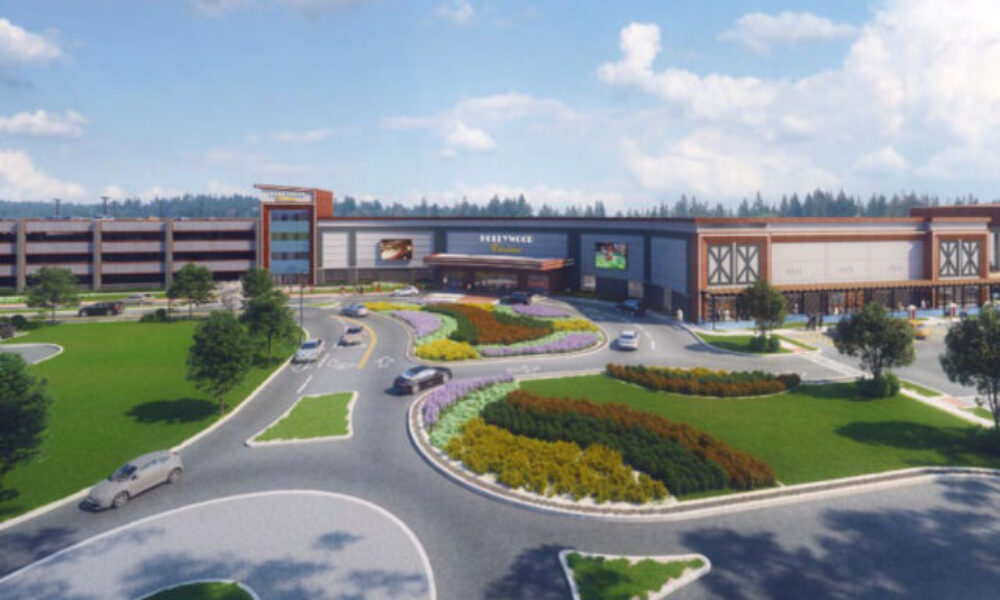A quartet of Wall Street gaming analysts attended the August 11 debut of Penn Entertainment’s new Hollywood Joliet in Illinois. Their reactions were published August 13.
“This is what a regional casino should look like,” enthused Jefferies Equity Research analyst David Katz. He opined that the $185 million investment “is appropriate, the amenity and food offerings are strong, and the location is a considerable upgrade from the prior riverboat access.”
Katz continued that there were risks inherent to the crowded Chicagoland market and it was uncertain whether or not the new casino would find an audience. But he found a return on investment in the 15 percent range to be plausible.
J.P. Morgan analyst Daniel Politzer agreed that such an ROI was “not herculean.” Compared to the previous Hollywood Joliet on a riverboat, “the change is night and day. Its openness/natural light and high-quality/celebrity-chef F&B evoke a Durango-esque feel, with some asking if this property is too nice for this market.”
Politzer added that Penn had superseded its old movie-oriented theme in favor of “a casino feel that is more airy, has natural light, and a more robust mix of F&B and entertainment options.” He particularly noted the banishment of “generic steakhouses.”
Deutsche Bank analyst Steven Pizzella missed the Monday-night debut. “Reports of opening night are that it was very busy, with some noting a tough time even finding a parking spot,” he wrote. “Despite our tour being on a Tuesday afternoon, casino foot traffic was solid the whole time we were there.”
Pizzella deemed the casino “essentially on par with some of the nicer regional gaming casinos, with an emphasis on technology, removing friction from the guest experience. In addition, we were impressed by the quality of food outlets at the property, which include several James Beard award winners.”
Leaving aesthetics aside, Truist Securities analyst Barry Jonas enumerated the casino’s asset base: 1,050 slot machines, 43 table games, a baccarat room, and an ESPN Bet-branded sports book. He agreed that Hollywood Joliet is “in a much more favorable location (adjacent to I-80 & I-55) than the legacy facility.”
Politzer ticked off other statistics, including a near-doubling of the casino workforce from 350 at the former site to as many as 600 in the new venue. Pointing out that this was the first new casino Joliet had seen in 30 years, he noted that its number of gambling positions could eventually be expanded to 2,000.
Jonas reported that regional-gaming trends are continuing to be auspicious into the third quarter of 2025. According to Penn, the numbers are “being fueled by consistent strength from rated play and momentum from the unrated segment” for the first time in two and a half years.
Analysts toured both the new casino and Penn’s in-progress facility in nearby Aurora. For Katz, the visit sent “constructive messages … The internal investment in land-based properties implies competitive downside and perhaps growth longer term and suggests limited resource allocation requirements toward digital.”
Katz continued that Penn’s investment of $650 million into Joliet, Aurora, and two other markets “presents important issues for regional gaming generally, rather than just Penn. Operators are responding to the intensity of competition in their markets from new licenses, alternative machine gaming, and digital, with capital investments to mitigate the deterioration in market share.” He applauded Penn for limiting casino amenities, in light of more intense competition.
Pizzella noted that Penn had imported the majority of its wholly owned slots from the old Hollywood Joliet, but replaced the entirety of its leased machines. Executives of Penn (CEO Jay Snowden was on hand) contended that they would take business from casinos within a 50-mile radius of Joliet.
The company also looked to extend its reach with the oncoming Aurora casino, targeting Naperville in particular. The new $360 million Hollywood Aurora is slated for 1,000 slots, 65 table games, and a sportsbook. It will be located near a premium outlet mall and Penn predicted it would have 10 times the foot traffic of the current Aurora casino. Unlike Hollywood Joliet, it will have a hotel, with 225 rooms.
“With regional gaming improving and Penn moving from defense to offense in a number of markets, we think the company’s retail segment could see upwards earnings revisions,” predicted Jonas. Penn didn’t update earnings guidance during the Joliet opening.
Nor is the company abandoning igaming. Penn execs stated their belief that “land-based operators who have invested millions in analog operations (including those in the ‘anti-igaming’ coalition) should be treated more favorably vs. digital-only players,” Jonas reported. They were confident of igaming expansion, considering the condition of state-level budgets, and believed i-gaming could drive in-person gambling.
Katz wasn’t mollified. He said Penn still had to answer for the money spent pursuing online sports betting. “Even if the football season exceeds low expectations, the prospects for reasonable returns are highly unlikely,” he wrote.
Looking even further into the future, Penn brass told Politzer they might have four or five more riverboat-to-land casino projects in the offing. All were projected to have 15 percent ROI.
Cautioned Katz, “The already-announced project plans do require meaningful capital spend, which, in turn, will require demonstrated execution before cash flow pivots and the investment is rewarded. In the end, Penn doesn’t meet our long-term fundamental criteria of growth clarity and execution for sustained upside in the shares, in our view.”



